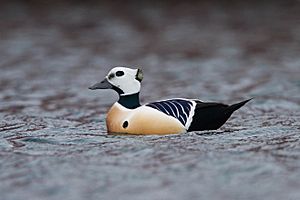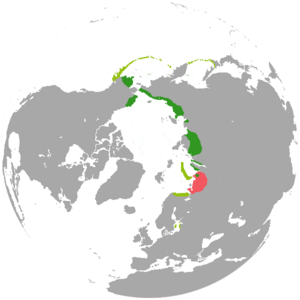Steller's eider facts for kids
The Steller's eider (Polysticta stelleri) is a special type of sea duck. It lives and has its babies along the cold, icy coasts of eastern Siberia and Alaska in the Arctic region.
Quick facts for kids Steller's eider |
|
|---|---|
 |
|
| A drake | |
 |
|
| A duck | |
| Conservation status | |
| Scientific classification | |
| Genus: |
Polysticta
|
| Species: |
stelleri
|
 |
|
Contents
What Does the Steller's Eider Look Like?
The Steller's eider is the smallest type of eider duck. It is about 45 cm (18 in) long.
Male Steller's Eider (Drake)
The male Steller's eider, called a drake, is easy to spot.
- It has a white head with a thick black ring around its eye.
- There are greenish-black feathers on its forehead and the back of its head.
- Its chin, throat, neck, back, tail, and rump are all black.
- Its wings are a dark bluish-purple with white edges. When its wings are folded, they look striped on its back.
- A special part of its wing, called the speculum, is metallic blue with white borders.
- Its chest and sides are a warm cinnamon-buff color. There is a black spot on each side, just above the water.
- Its legs, feet, and bill are dark bluish-grey.
Female Steller's Eider (Duck)
The female Steller's eider, called a duck or hen, is dark brown. She is smaller than the male. Her head and body look more like a typical duck compared to other eider species.
Sounds They Make
The male Steller's eider makes a deep, soft cooing sound. It is quieter than other eider ducks. The female makes different grunting and whistling sounds.
| How Big Are They? | |
|---|---|
| Length | 430–460 mm (17–18 in) |
| Weight | 860 g (1.90 lb) |
| Wingspan | 690 mm (27 in) |
| Wing | 210–225 mm (8.3–8.9 in) |
| Bill length | 37–42 mm (1.5–1.7 in) |
| Leg length | 36–40 mm (1.4–1.6 in) |
Where Do Steller's Eiders Live?
Steller's eiders build their nests on the tundra, which is a flat, treeless plain. They like to build their nests close to the sea. A female usually lays 6 to 10 eggs in her nest.
Migration and Winter Homes
These ducks are migratory birds. This means they travel to different places depending on the season.
- They spend the winter a bit further south.
- Their winter homes include the Bering Sea, northern Scandinavia, and the Baltic Sea.
- Sometimes, huge groups of Steller's eiders can gather together. Flocks of up to 200,000 birds have been seen in good coastal areas.
What Do They Eat?
Steller's eiders are good divers. They dive underwater to find their food. They mostly eat crustaceans (like crabs and shrimp) and molluscs (like snails and clams). Mussels are one of their favorite foods.
Hybridization: Mixing Species
Sometimes, different types of ducks can have babies together. This is called hybridisation.
- Steller's eiders are thought to have mixed with the common eider at least two times in the wild.
- There have also been thoughts that they might mix with mallard ducks.
Protecting Steller's Eiders
The Steller's eider is a species that needs protection.
- It is part of an agreement called the Agreement on the Conservation of African-Eurasian Migratory Waterbirds (AEWA). This agreement helps protect waterbirds that travel long distances.
- There is also a special plan in Alaska to help the Steller's eider population grow and recover.
See also
 In Spanish: Eider de Steller para niños
In Spanish: Eider de Steller para niños


